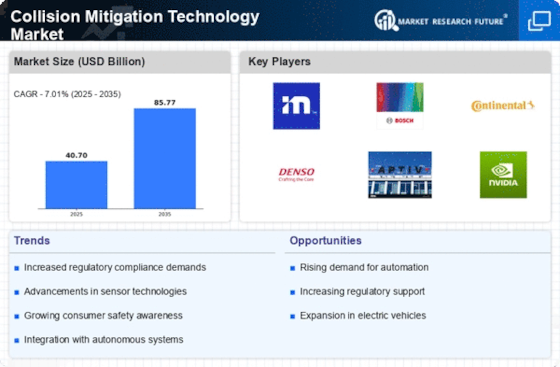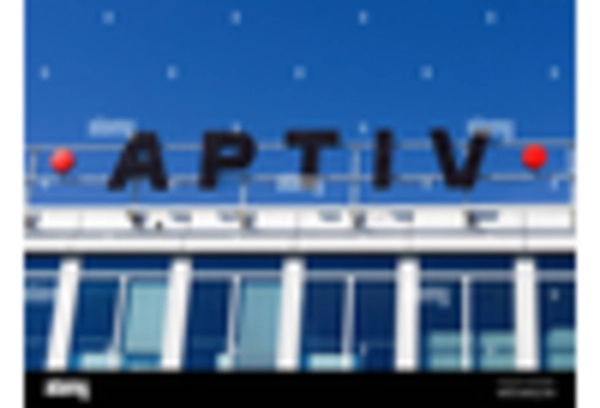Rising Road Safety Concerns
The Collision Mitigation Technology Market is experiencing a surge in demand due to increasing concerns regarding road safety. With traffic accidents resulting in significant fatalities and injuries, stakeholders are prioritizing the implementation of advanced safety technologies. According to recent statistics, road traffic injuries are among the leading causes of death worldwide, prompting governments and organizations to advocate for enhanced safety measures. This heightened awareness is driving investments in collision mitigation technologies, as they are perceived as essential tools for reducing accident rates. The market is projected to grow as more consumers and manufacturers recognize the importance of these technologies in ensuring safer driving experiences. As a result, the Collision Mitigation Technology Market is likely to expand, with innovations aimed at preventing collisions becoming a focal point for automotive manufacturers.
Government Regulations and Incentives
The Collision Mitigation Technology Market is significantly shaped by government regulations and incentives aimed at improving road safety. Many countries are implementing stringent safety standards that require the incorporation of collision mitigation technologies in new vehicles. These regulations are often accompanied by incentives for manufacturers who adopt advanced safety features, further encouraging the development of innovative solutions. As governments recognize the economic and social benefits of reducing traffic accidents, they are likely to continue supporting the adoption of these technologies through policy measures. This regulatory environment is expected to drive growth in the Collision Mitigation Technology Market, as compliance with safety standards becomes a critical factor for automotive manufacturers. The alignment of regulatory frameworks with technological advancements is likely to create a conducive atmosphere for market expansion.
Increased Investment in Research and Development
The Collision Mitigation Technology Market is witnessing a notable increase in investment in research and development (R&D) activities. As competition intensifies among automotive manufacturers, there is a growing emphasis on developing innovative collision mitigation solutions. Companies are allocating substantial resources to R&D to enhance the effectiveness and reliability of these technologies. This trend is indicative of a broader commitment to improving vehicle safety and reducing accident rates. The Collision Mitigation Technology Market is expected to benefit from these investments, as advancements in technology lead to the introduction of more effective collision prevention systems. Furthermore, collaboration between automotive manufacturers and technology firms is likely to foster innovation, resulting in a diverse array of solutions that cater to various consumer needs and preferences.
Technological Advancements in Sensors and Software
The Collision Mitigation Technology Market is significantly influenced by rapid advancements in sensor and software technologies. Innovations in radar, lidar, and camera systems are enhancing the capabilities of collision mitigation systems, allowing for more accurate detection of potential hazards. The integration of artificial intelligence and machine learning algorithms is further improving the responsiveness and effectiveness of these technologies. As a result, the market is witnessing a shift towards more sophisticated systems that can analyze real-time data and make split-second decisions to prevent accidents. This technological evolution is expected to drive growth in the Collision Mitigation Technology Market, as manufacturers seek to incorporate cutting-edge solutions into their vehicles. The increasing complexity of urban environments necessitates these advancements, making them crucial for the future of automotive safety.
Consumer Demand for Enhanced Vehicle Safety Features
The Collision Mitigation Technology Market is being propelled by a growing consumer demand for enhanced vehicle safety features. As awareness of road safety issues rises, consumers are increasingly seeking vehicles equipped with advanced collision mitigation technologies. Market Research Future indicates that a significant percentage of potential car buyers prioritize safety features when making purchasing decisions. This trend is prompting automotive manufacturers to invest in the development and integration of these technologies into their vehicles. The Collision Mitigation Technology Market is likely to benefit from this shift in consumer preferences, as manufacturers strive to meet the expectations of safety-conscious consumers. Consequently, the market is expected to expand, with a diverse range of collision mitigation solutions becoming standard offerings in new vehicles.


















Leave a Comment